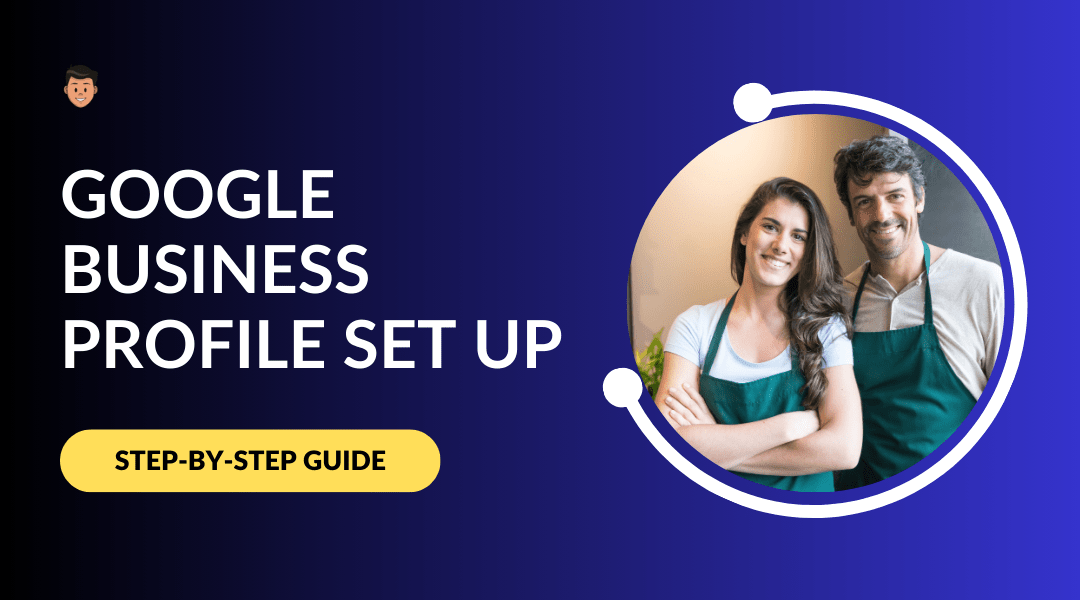Your Google Business Profile (GBP) is the single most important asset for winning local customers in 2025. It’s free, visible everywhere your customers search, and when optimized correctly, it can bring in leads every single day without spending on ads.
The problem is, most business owners either leave their profile half-finished or copy whatever Google suggests by default. That mistake costs rankings, visibility, and revenue. The good news: a fully optimized profile isn’t complicated. You just need to follow a clear checklist and use a few free tools along the way.
In this guide, I’ll walk you through seven proven steps to optimize your GBP: from choosing the right categories and writing a strong description, to geotagging photos, posting updates, managing reviews, and keeping your NAP consistent across the web. Each step is simple, actionable, and designed to help you dominate your local area.
Quick Overview: Key Steps at a Glance
| Feature/Step | Why It Matters | Pros | Cons |
|---|---|---|---|
| Primary & Secondary Categories | Drive Map Pack visibility and match you to the right searches | Boosts local rankings, aligns with customer intent | Easy to misclassify if you guess instead of research |
| Business Description | Explains who you are and what you do | Builds trust, adds keywords naturally | Limited to 750 characters, so must stay concise |
| Geotagged Photos | Connect visuals to your location | Builds trust with real images, signals activity | Takes extra time to tag photos before upload |
| Google Posts | Keeps your profile fresh and engaging | Drives clicks, promotes offers and events | Needs consistent posting to stay effective |
| Reviews | Provide trust and strong SEO signals | Boosts rankings, works as social proof | Negative reviews hurt if left unanswered |
| NAP Consistency | Confirms your identity across the web | Helps Google trust your business details | Errors across platforms can harm visibility |
1. Choose the Right Primary and Secondary Categories
Identify local competitors
Start by identifying your local competitors because their categories reveal what drives rankings in your market. Categories act as Google’s filters, so knowing who appears for “plumber near me” or “dentist Long Beach” tells you which labels work. For instance, if three nearby plumbers all use “Plumber” as their primary, that’s the baseline. Collect these examples so you know what to test in the next audit.
Audit the competition
Audit competitor listings to uncover patterns and opportunities. The reason this works is that Google tends to reward consistency in category choice within a local niche. For example, if top-ranked salons share “Hair Salon” as primary and “Beauty Salon” as secondary, you know those are safe anchors. Note overlaps and gaps in a spreadsheet so you can align with proven choices while spotting underused secondaries.
Optimize GMB categories
Optimize your categories by using the most specific option as your primary and broader ones as secondaries. The primary drives map pack visibility, while secondaries expand reach into related searches.
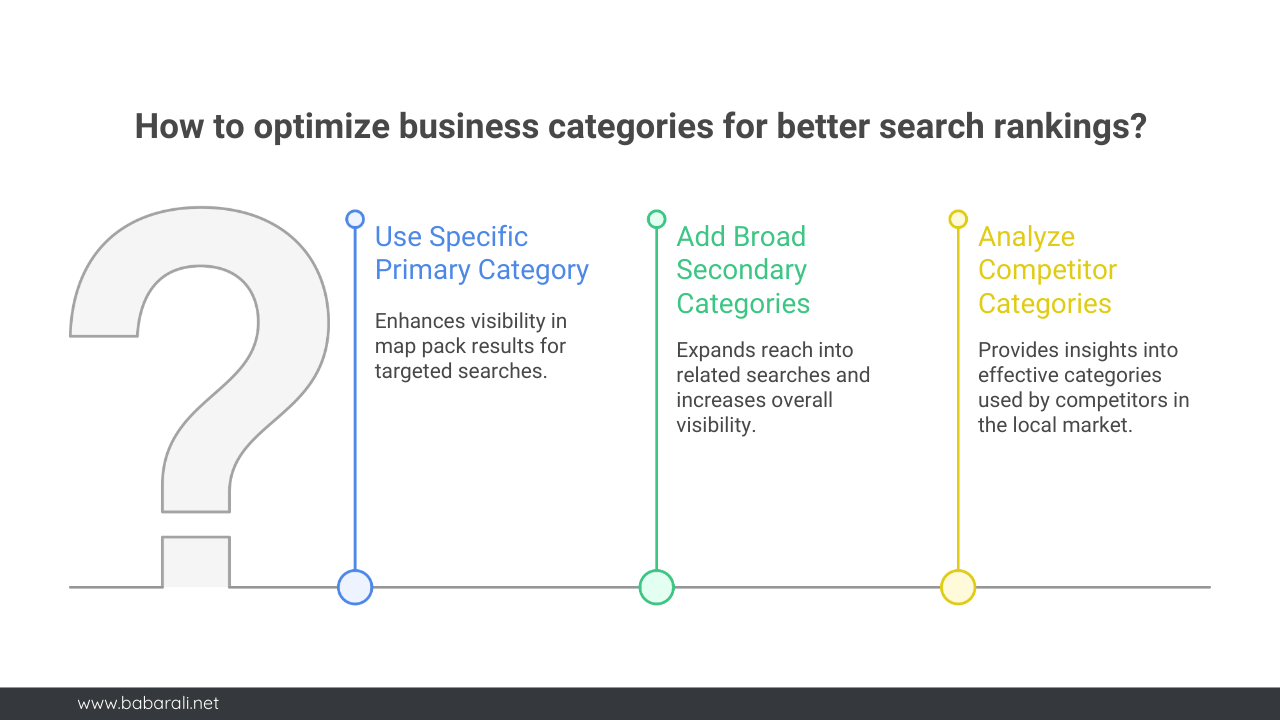
For example, “Emergency Plumber” outperforms the generic “Plumber” if emergency calls are your main business. Adding “Water Heater Installation” or “Bathroom Remodeler” as secondary categories helps you appear in more searches.
Your primary category is the single most important label, it’s what Google uses to decide which main searches you can show up for (e.g., “Plumber” or “Dentist”). Think of it as your business’s headline.
Additional categories are supporting tags. They don’t carry as much weight but expand your reach into related searches (e.g., “Water Heater Installation” or “Cosmetic Dentist”). They work best when they’re relevant to your actual services, not random extras.
To find the right mix, use a free tool like GMB Everywhere. This Chrome extension shows the exact primary and secondary categories competitors are using. It’s free, works on Windows and Mac, and gives you valuable insights into what’s working in your market.
Use this rule: choose the narrowest accurate primary, then stack related secondaries for broader coverage.
2. Write a Compelling Business Description
A good business description should clearly state who you are, what you do, and where you serve. Start with your business name, your core service, and location, then add one or two unique traits or values. Use this quick formula:
✅ Formula to follow every time:[Business name] + [What you do] + [Where] + [Unique traits/values] + [Benefit to customer]
Example: “Parley’s PPM Plumbing has served Utah County for 40 years with trusted plumbing, heating, and AC repair.”
Do’s and Don’ts (GBP-specific)
| ✅ Do’s | ❌ Don’ts |
|---|---|
| Keep within 750 characters (2–3 short paragraphs) | Don’t keyword stuff or repeat phrases |
| Include main service + location early in the text | Don’t copy-paste your homepage content |
| Highlight unique traits (family-owned, eco-friendly, since [year]) | Don’t use hype words like “best in town” |
| Use active voice (“We provide fast service”) | Don’t write in passive, vague language |
| Frame services as benefits (“Save time with flexible scheduling”) | Don’t ignore customer perspective |
Generate Your Description in Seconds
If writing feels slow, use the free AI description generator on my website. Enter your business details, and it produces a keyword-rich, locally optimized description instantly. You can publish it as-is or edit lightly to match your brand’s tone.
3. Upload and Geotag High-Quality Photos
Post new images to your Google Business Profile at least once a month. Fresh photos show customers you’re active and signal to Google that your business is real and engaged. For example, adding updated storefront or service-in-action shots helps boost trust.
Ensure each image is properly geotagged
Geotagging embeds GPS coordinates in your photos, telling Google exactly where the image was taken. This strengthens the link between your business and your service area, improving local rankings in Google Maps.
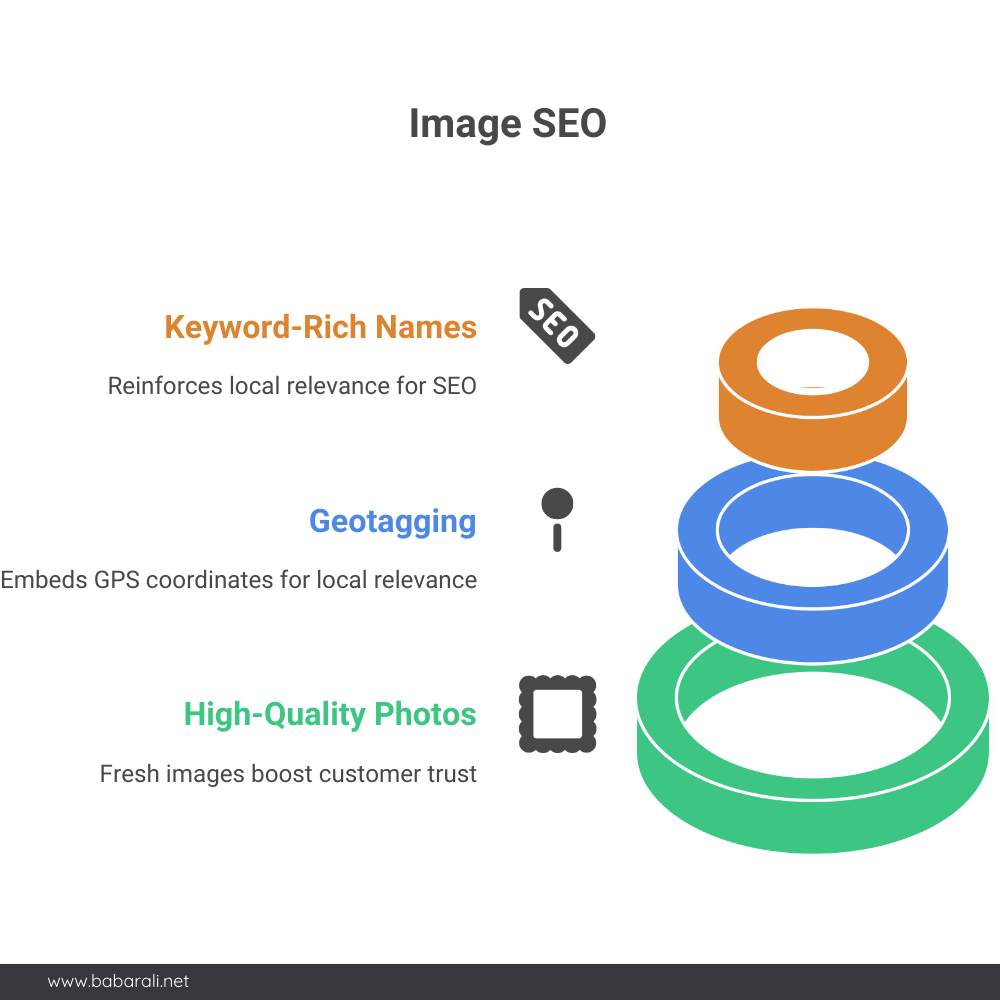
Why geotagging matters
Always upload high-quality, geotagged photos with keyword-rich file names to reinforce local relevance. For example, rename IMG1234.jpg to chula-vista-house-cleaning-team.jpg before uploading. This small step makes your visuals work harder for SEO.
Free tool to geotag your photos
You can geotag images in seconds with the GeoTag Images Tool I built. Upload a JPG, PNG, or WebP file, drop a pin on the map, and download your photo with embedded GPS data. It’s 100% free, browser-based, and your files never leave your device.
4. Post Regular Updates with Google Posts
Google Posts keep your profile fresh and help customers engage with your business directly in search. New posts surface first, while older ones remain under “View all,” so consistent posting signals activity to Google.
Cadence and formats
Post at least once per week. Use the right type: What’s New for updates, Offer with start/end dates, Event for time-bound promotions, and Product for evergreen items. Each post should run 80–120 words.
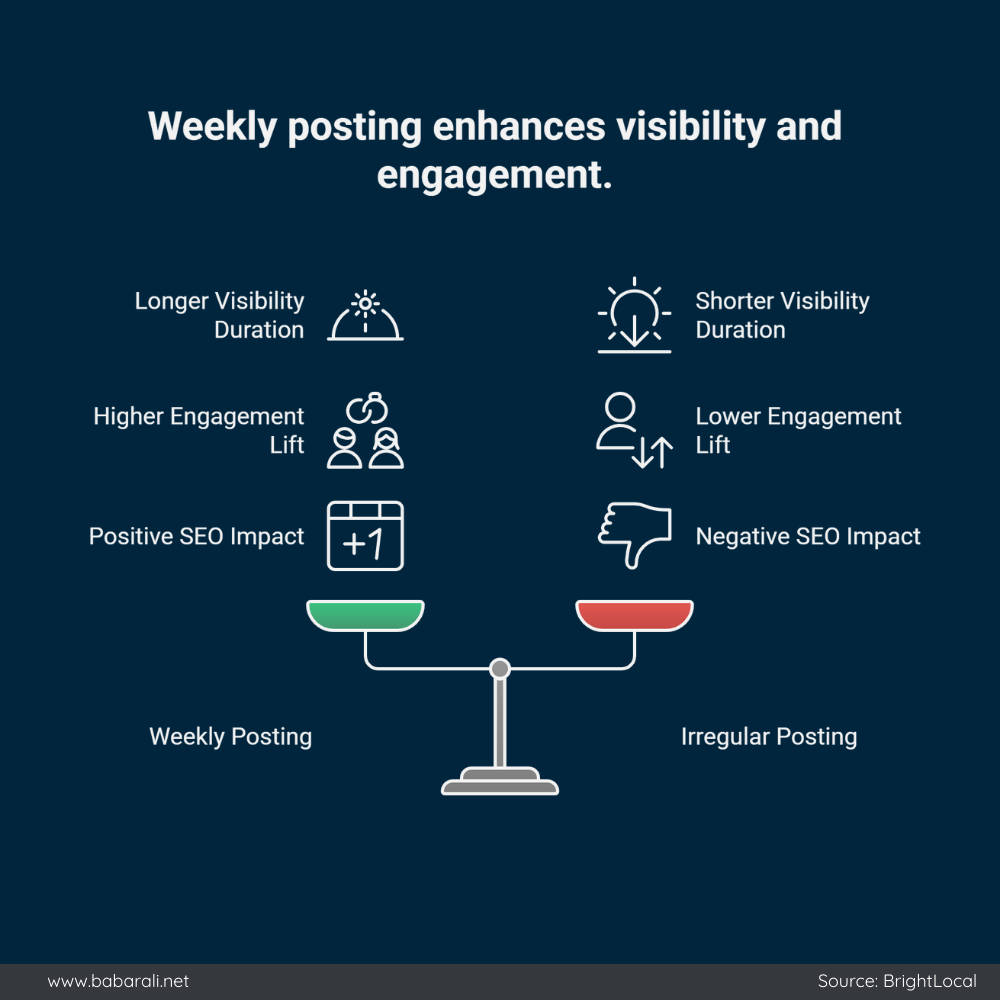
Copy formula (made simple)
Think of a Google Post like a mini ad on your Business Profile. It should be short, clear, and show customers why they should act now. Keep it around 80–120 words and follow this 3-line structure:
Line 1: Benefit + Local Cue
Start with the value you offer and mention your city. This grabs attention and signals relevance.
Example: “Need same-day carpet cleaning in Dallas? We’ll make your floors look brand new today.”
Line 2: Proof or Detail
Give one supporting fact: timeframe, price, or special offer. This builds trust and answers a common question.
Example: “Most homes are finished in 90 minutes, and our deep clean includes kitchens and bathrooms.”
Line 3: Call to Action (CTA)
End with a clear action and choose the matching button Google provides (Call now, Book, Learn more, Sign up).
Example: “Tap ‘Book now’ to reserve your cleaning slot today.”
5. Complete Every Field in Your Profile
Complete, accurate fields reduce friction for customers and send stronger trust signals to Google. A profile that looks finished is more likely to rank and more likely to convert.
Set accurate business hours
Keep your hours exact and current so customers know when you’re open. Wrong hours frustrate people and often lead to bad reviews. Add regular hours, holiday hours, and temporary changes. Always make sure they match what’s on your website.
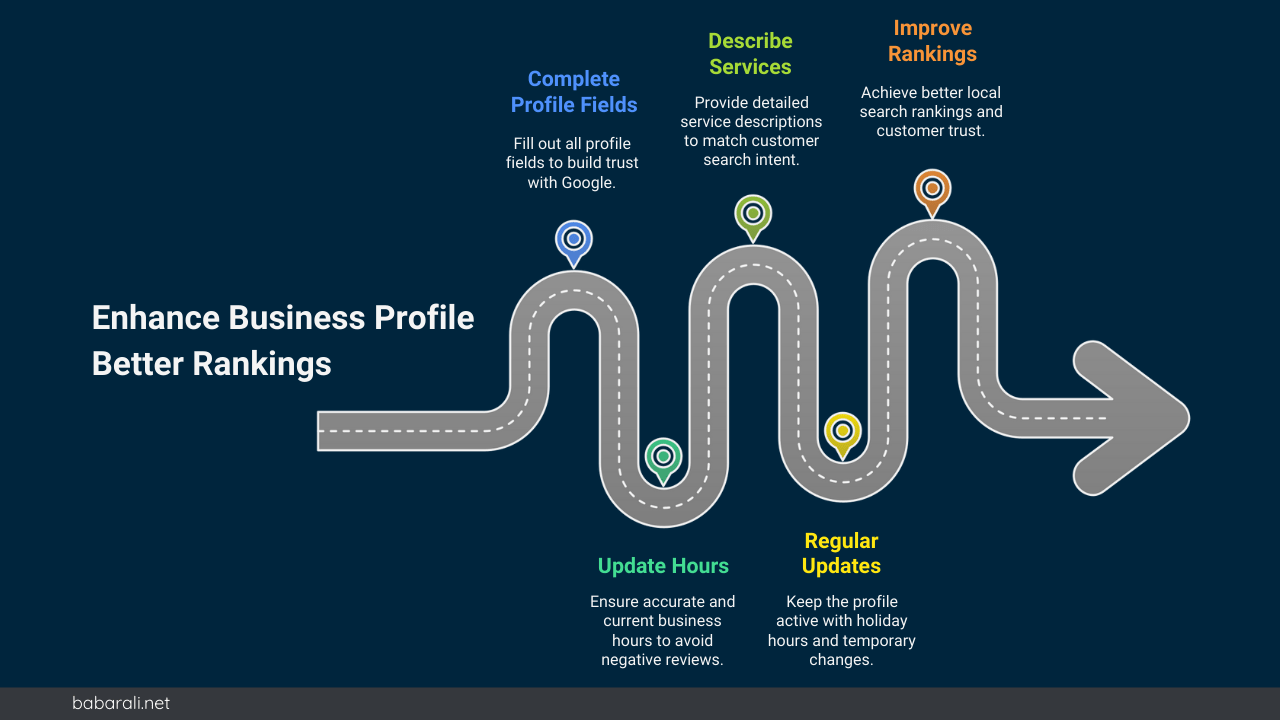
Add services and detailed offerings
List every core service with a clear, non-branded name customers search for. Add a one-line description that explains the benefit or scope. Example: “Water Heater Repair – Fast same-day service for residential units in Austin.” Start with your top money-makers and expand over time.
6. Manage and Reply to Customer Reviews
Customer reviews build trust, influence buying decisions, and improve your Google Business Profile rankings. A steady flow of authentic reviews is one of the strongest signals for local SEO.
Encourage reviews
Ask happy customers to leave a review right after a positive interaction. Share your direct Google review link in follow-up emails or texts to make it easy. Never offer incentives — it violates Google’s policies.
Respond to every review
Replying shows you value feedback and builds trust with future customers. For positives, thank the customer and reinforce what they mentioned. For negatives, acknowledge the problem, apologize, and invite them to continue the conversation privately.
Example responses:
- Positive Review:
“Thank you, Sarah! We’re glad our same-day plumbing service made things easier for you. We look forward to helping again whenever you need us.” - Negative Review (service delay):
“Hi Mark, we’re sorry your appointment didn’t start on time. We understand how important punctuality is and will review our scheduling process. Please reach us at [email/phone] so we can make this right for you.” - Negative Review (quality issue):
“Hi Ana, thank you for your feedback. We’re disappointed to hear the deep clean didn’t meet expectations. We’d like to fix this — please contact us directly so we can send a team back at no extra cost.” - Negative Review (miscommunication):
“Hi James, sorry for the confusion about pricing. Our goal is always upfront and transparent quotes. Please give us a call so we can clarify and ensure you’re taken care of.”
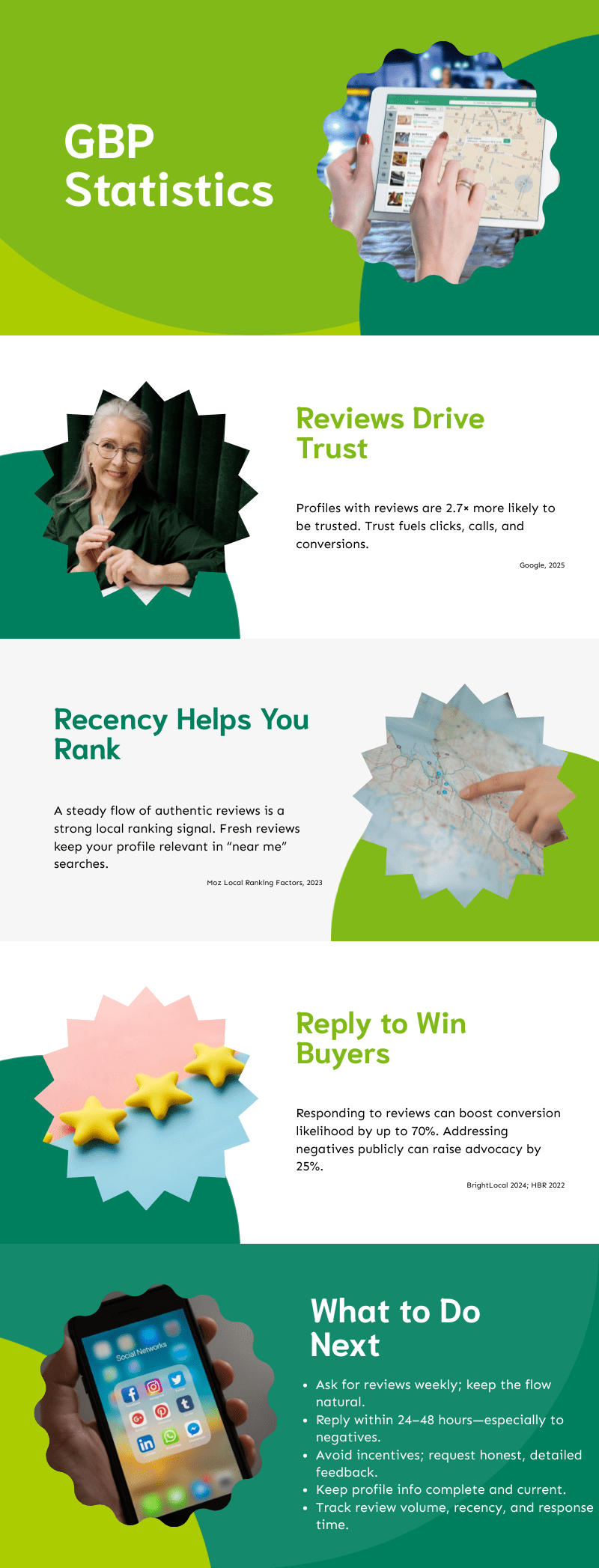
References: Google- BrightLocal – Moz
7. Maintain NAP Consistency Across the Web
Google rewards consistency. If your Name, Address, Phone, and Website (NAP+W) appear the same everywhere — Google, Yelp, Facebook, directories — it helps search engines trust your business. Inconsistent details (like “St.” vs. “Street”) confuse Google and hurt rankings.
Keep website links accurate
Always use your one official website URL (with HTTPS). Don’t link to a page that redirects. If you track clicks, add UTM codes (?utm_source=google&utm_medium=organic&utm_campaign=gbp) — Google ignores the tracking, but still sees your main URL as the authority.
Use LocalBusiness schema markup
Add JSON-LD schema to the page you link from GBP. It tells Google who you are and where you operate. Include your business name, phone, full address, hours, and social links.
{
"@context": "https://schema.org",
"@type": "LocalBusiness",
"name": "[Your Business Name]",
"url": "https://www.example.com/",
"telephone": "+1-555-123-4567",
"address": {
"@type": "PostalAddress",
"streetAddress": "123 Main St",
"addressLocality": "Chula Vista",
"addressRegion": "CA",
"postalCode": "91910",
"addressCountry": "US"
},
"geo": {
"@type": "GeoCoordinates",
"latitude": 32.6401,
"longitude": -117.0842
},
"openingHoursSpecification": [{
"@type": "OpeningHoursSpecification",
"dayOfWeek": ["Monday","Tuesday","Wednesday","Thursday","Friday"],
"opens": "08:00",
"closes": "18:00"
}],
"sameAs": [
"https://www.facebook.com/yourpage",
"https://www.instagram.com/yourhandle",
"https://www.linkedin.com/company/yourcompany"
]
}Connect social profiles
Add your official Facebook, Instagram, or LinkedIn inside your GBP under Social profiles. Match those same URLs in your schema “sameAs” field and on your website footer to reinforce authority.
Check CRO elements
Your GBP should convert, not just rank. Use the best landing page for your website link (e.g., city or service page, not always homepage). Add appointment links, booking buttons, or menu pages if relevant. Keep the first two lines of your description customer-focused: benefit + proof.
Verify your listing
Stay verified. Major edits (like name, address, or category changes) can trigger a re-verification process, and without it your profile may lose visibility. Always check status after big updates.
FAQs
Use your real-world business name exactly as shown on signage and branding; don’t add keywords, locations, URLs, taglines, hours, or services to the name. Reason: your name is a core trust signal and keyword stuffing breaches policy. Specific: “Mike’s Plumbing” is compliant; “Mike’s Plumbing – Best Dallas Drain Cleaning” is not. Action: match your legal/brand name everywhere (GBP, storefront, website, invoices) to avoid edits or suspension. read more
No. Incentivizing reviews (money, discounts, freebies, or “coupon for changing a negative review”) violates Google’s Fake engagement policy and can trigger profile restrictions; it also risks enforcement under the FTC’s Endorsement Guides. Specific: Google explicitly bans “payment, discounts, free goods and/or services” in exchange for reviews; FTC requires honest, unbiased endorsements. Action: ask neutrally after service, share your direct review link, never gate or incentivize. sources: 1 2
Link to the most relevant page for the searcher: homepage for single-location, broad intent; location page for multi-location searches; service page for niche intent (e.g., “water heater repair in Austin”). Reason: Google ranks on relevance, distance, prominence, so sending users to a page that answers the query improves engagement and conversions. Specific: multi-city dentists should link each GBP to its dedicated city/location page; track clicks in GBP Performance. Action: set page per location, add UTM, and review Performance monthly.
Final Words
If you follow this checklist, your GBP becomes more than a listing; it becomes your most reliable lead machine. Test these steps on your own profile, track results in Google Insights, and refine as you go. Once you’re at the top, you won’t just compete, you’ll dominate your local area.
Need expert help with Google Business Profile or local SEO? Contact me today and let’s get your business ranking where it belongs.




